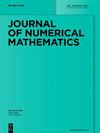如何证明自适应最小二乘有限元方法的最优收敛率
IF 4
2区 数学
Q1 MATHEMATICS
引用次数: 1
摘要
摘要自适应最小二乘有限元法(alsems)的收敛率分析结合了符合和混合有限元格式的后验分析结果。本文综述了线性模型问题的非线性有限元法自适应公理验证的关键论点。手边的公式允许同时分析泊松模型问题、斯托克斯方程和线性弹性方程的一阶系统。继[Carstensen和Park, SIAM J. number]。[au:] [j] . 53(1), 2015],该自适应算法由具有精确解的可选残差误差估计器驱动,并包含用于右侧准最优数据分辨率的单独标记策略。本文讨论了任意多项式次和混合齐次边界条件下的一致性离散。本文章由计算机程序翻译,如有差异,请以英文原文为准。
How to prove optimal convergence rates for adaptive least-squares finite element methods
Abstract The convergence analysis with rates for adaptive least-squares finite element methods (ALSFEMs) combines arguments from the a posteriori analysis of conforming and mixed finite element schemes. This paper provides an overview of the key arguments for the verification of the axioms of adaptivity for an ALSFEM for the solution of a linear model problem. The formulation at hand allows for the simultaneous analysis of first-order systems of the Poisson model problem, the Stokes equations, and the linear elasticity equations. Following [Carstensen and Park, SIAM J. Numer. Anal. 53(1), 2015], the adaptive algorithm is driven by an alternative residual-based error estimator with exact solve and includes a separate marking strategy for quasi-optimal data resolution of the right-hand side. This presentation covers conforming discretisations for an arbitrary polynomial degree and mixed homogeneous boundary conditions.
求助全文
通过发布文献求助,成功后即可免费获取论文全文。
去求助
来源期刊
CiteScore
5.90
自引率
3.30%
发文量
17
审稿时长
>12 weeks
期刊介绍:
The Journal of Numerical Mathematics (formerly East-West Journal of Numerical Mathematics) contains high-quality papers featuring contemporary research in all areas of Numerical Mathematics. This includes the development, analysis, and implementation of new and innovative methods in Numerical Linear Algebra, Numerical Analysis, Optimal Control/Optimization, and Scientific Computing. The journal will also publish applications-oriented papers with significant mathematical content in computational fluid dynamics and other areas of computational engineering, finance, and life sciences.

 求助内容:
求助内容: 应助结果提醒方式:
应助结果提醒方式:


